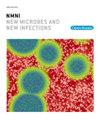Assessment of human Herpes Virus-8 infection in Iranian cirrhotic patients on the waiting list for liver transplantation: A cross-sectional analysis
IF 2.9
Q2 INFECTIOUS DISEASES
引用次数: 0
Abstract
Background
Human Herpes Virus 8 (HHV-8) is involved in autoimmunity. However, its association with advanced liver disease has not been fully explained. Herein, the prevalence of HHV-8 viremia was assessed in Iranian liver transplant candidates with a confirmed diagnosis of cirrhosis.
Methods
This cross-sectional study was conducted on 230 patients with cryptogenic cirrhosis, virus-related cirrhosis, and autoimmune hepatitis, as well as 140 healthy blood donors from April 2022 to September 2023. The HHV-8 IgG antibody concentration and viral load were evaluated via ELISA and RT‒PCR, respectively.
Results
Anti-HHV-8 IgG antibodies were detected in 25 cirrhotic patients (10.8 %) and four healthy individuals (2.6 %) (p = 0.022). The majority of the seropositive patients had cryptogenic cirrhosis (20.4 %), followed by autoimmune hepatitis (13.1 %) and virus-related cirrhosis (4.7 %). The seropositivity of HHV-8 IgG antibody was significantly different among the etiologies of liver cirrhosis (p = 0.011). However, HHV-8 genomic DNA was not detected in the sera of the patients or healthy blood donors.
Conclusion
The role of HHV-8 infection in the development of posttransplant diseases, together with the higher seroprevalence of HHV-8 antibodies in cirrhotic patients than in healthy individuals, highlights the importance of both primary and latent infections in liver transplantation. Therefore, serological and molecular screening of HHV-8 is highly suggested for liver transplant candidates and organ donors. The possibility of antibody-mediated epitope mimicry in cryptogenic and autoimmune groups with moderate HHV-8 antibody positivity and negative viral loads may account for the development of advanced liver diseases.
评估等待肝移植的伊朗肝硬化患者的人类疱疹病毒-8 感染情况:横断面分析
背景人类疱疹病毒 8(HHV-8)与自身免疫有关。然而,它与晚期肝病的关系尚未得到充分解释。方法这项横断面研究是在 2022 年 4 月至 2023 年 9 月期间对 230 名隐源性肝硬化、病毒相关性肝硬化和自身免疫性肝炎患者以及 140 名健康献血者进行的。结果在 25 名肝硬化患者(10.8%)和 4 名健康人(2.6%)中检测到抗 HHV-8 IgG 抗体(P = 0.022)。大多数血清阳性患者患有隐源性肝硬化(20.4%),其次是自身免疫性肝炎(13.1%)和病毒相关性肝硬化(4.7%)。不同病因导致的肝硬化患者的 HHV-8 IgG 抗体血清阳性率存在显著差异(p = 0.011)。结论 HHV-8 感染在移植后疾病发展中的作用,以及肝硬化患者的 HHV-8 抗体血清阳性率高于健康人,突出了原发性和潜伏性感染在肝移植中的重要性。因此,强烈建议对肝移植候选者和器官捐献者进行 HHV-8 血清学和分子筛查。在中度 HHV-8 抗体阳性和病毒载量阴性的隐源性和自身免疫性群体中,抗体介导的表位模仿可能是晚期肝病发生的原因。
本文章由计算机程序翻译,如有差异,请以英文原文为准。
求助全文
约1分钟内获得全文
求助全文
来源期刊

New Microbes and New Infections
Medicine-Infectious Diseases
CiteScore
10.00
自引率
2.50%
发文量
91
审稿时长
114 days
 求助内容:
求助内容: 应助结果提醒方式:
应助结果提醒方式:


